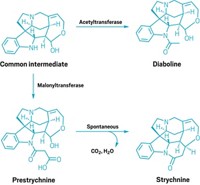Advertisement
Grab your lab coat. Let's get started
Welcome!
Welcome!
Create an account below to get 6 C&EN articles per month, receive newsletters and more - all free.
It seems this is your first time logging in online. Please enter the following information to continue.
As an ACS member you automatically get access to this site. All we need is few more details to create your reading experience.
Not you? Sign in with a different account.
Not you? Sign in with a different account.
ERROR 1
ERROR 1
ERROR 2
ERROR 2
ERROR 2
ERROR 2
ERROR 2
Password and Confirm password must match.
If you have an ACS member number, please enter it here so we can link this account to your membership. (optional)
ERROR 2
ACS values your privacy. By submitting your information, you are gaining access to C&EN and subscribing to our weekly newsletter. We use the information you provide to make your reading experience better, and we will never sell your data to third party members.
Synthesis
Unfavored Ring Route Revealed
Enzymology: Structure, theory answer question about how an unusual biosynthetic step works
by Stu Borman
March 5, 2012
| A version of this story appeared in
Volume 90, Issue 10

The first X-ray crystal structure of a biosynthetic enzyme and quantum chemical calculations have resolved a long-standing mystery about how bacteria are able to use a typically slow, seemingly unworkable type of chemical reaction to make six-membered rings in polyether antibiotics (Nature, DOI: 10.1038/nature10865).

The study could lead to greater use of similarly disfavored reactions in synthetic organic chemistry and in fermentation vats to create diverse natural-product-like compounds for drug discovery and other applications.
Since 1974, when the first studies on biosynthesis of the antibiotic lasalocid A were carried out, researchers have wondered how the natural product’s six-membered ether ring forms. In solution, the type of reaction that forms that ring is disfavored, according to Baldwin’s rules of ring closure, proposed in 1976 by Sir Jack Baldwin of Oxford University.
A few years ago, pharmaceutical chemist Hideaki Oikawa of Hokkaido University, Japan, and coworkers discovered Lsd19, the bacterial enzyme that catalyzes the epoxide-opening cyclization reaction that converts the biosynthetic precursor compound bisepoxyprelasalocid A into lasalocid A.
In the new study, crystallographer and drug developer Chu-Young Kim of the National University of Singapore and coworkers have obtained the first crystal structure of Lsd19.
The structure shows that precisely positioned active-site residues—a basic residue that deprotonates a hydroxyl and an acidic residue that activates opening of an epoxide—dramatically change the energetics of the cyclization reaction. The result is formation of a six-membered ring.
Computational organic chemists Robert S. Paton of Oxford University and Kendall N. Houk of UCLA collaborated with Kim and coworkers by carrying out quantum mechanical simulations that helped determine the mechanism. Also adding support to the new findings is a 1993 proposal by Houk and colleagues that a similar mechanism explains theoretically how a catalytic antibody works.
The study “gives a glimpse at the inner workings of nature’s design,” says synthetic organic chemist and biochemist Igor V. Alabugin of Florida State University. In the study, Kim and coworkers used “a very impressive blend of skills and techniques to solve a difficult problem,” he says.
The findings show “that when there are two competing reactions and one is strongly favored in solution, an enzyme can evolve to preferentially catalyze what would otherwise be the less favored reaction,” says mechanistic enzymologist David E. Cane of Brown University. “The enzyme doesn’t violate the laws of chemistry. It just has to find a few extra kilocalories to make the less favored reaction go faster.”
Lasalocid A’s six-membered cyclic ether is a common structural feature in hundreds of other natural products, and the findings could explain how many of them are formed in nature. Kim’s group has already found that seven microorganisms utilize the new mechanism for six-membered-ring formation. He believes the findings will lead to new ways to favor formation of six-membered rings in a range of polyether natural-product-like compounds and enhance the ability to create analogs with novel forms of bioactivity.





Join the conversation
Contact the reporter
Submit a Letter to the Editor for publication
Engage with us on Twitter